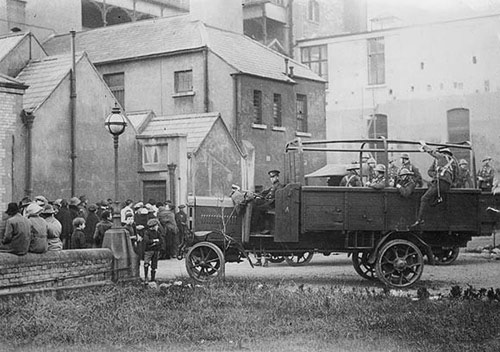A memorial is expected to be unveiled on July 25th next, 2021, in the C.J. Kickham’s GAA Club grounds at Mullinahone, Thurles, Co. Tipperary; latter to honour six players from the club, who played in Croke Park, on Bloody Sunday 1920.
The unveiling and commemoration were previously delayed, because of the Covid-19 pandemic, and is now expected to take place following 11.30am Mass in St. Michael’s Church on Sunday afternoon next.
Following Mass, a parade, led by a lone piper, will proceed to the unveiling of the Memorial in the Club’s sports ground. An oration will be delivered by Mr Seamus McCarthy of the Tipperary Bloody Sunday Memorial Committee.

[Note: Jervis Street Hospital closed in November 1987, before being redeveloped in the early 1990s to create the Jervis Shopping Centre. Only the facade of the original hospital remains today.]
The Club has expressed their thanks to the Brett family, latter who generously sponsored the memorial, thus ensuring a fitting tribute to those Tipperary men who witnessed player Michael Hogan, aged just 24 years and twelve match spectators, all unarmed, including Tipperary’s James Teehan aged 26, and Daniel Carroll aged 31, all gunned down by members of the RIC and Black & Tans in the sporting venue.
Huge thanks are also expressed to Mr Malachy Sheehan, latter who built the area in which the memorial will be housed.
Bloody Sunday
November 21st 1920, known as Bloody Sunday, was a day of extreme violence in Dublin city, over 100 years ago during the Irish War of Independence. Earlier in the morning, the Irish Republican Army (IRA) had mounted an operation against British intelligence officers and their informers, killing in total 15 identified operatives.
The Dublin Gaelic football team were scheduled to play the Tipperary team later on that same afternoon, in the Gaelic Athletic Association’s (GAA) major sports ground, known as Croke Park.
In retaliation, inside these grounds, shots were fired by police supposedly intending to search spectators for weapons.
Ammunition fired on that day included 114 rounds of rifle ammunition together with other projectiles fired over the heads of spectators from revolvers and an armoured car machine-gun. Just 90 seconds later, seven people lay dead, and five more lay wounded so badly that they later died of their injuries. Another two people were killed; same trampled and crushed by the panicking crowd. The dead included Ms Jane Boyle, who was due to be married five days later. Two boys aged ten and eleven were both shot dead. Two football players, Michael Hogan and Jim Egan were also shot; Egan survived, however, Hogan succumbed to his wounds; the only player fatality on that darkest of Sunday afternoons.

Leave a Reply